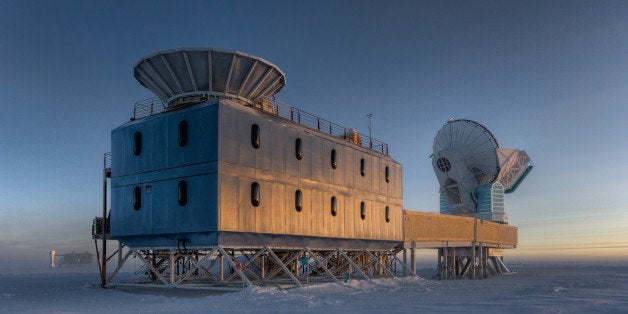
The evidence for the primordial gravitational waves that caused a sensation when it was announced in March could be less strong than previously thought, according to a cosmologist, adding to reports of existing rumours that questioned the work.
The observation recorded by the BICEP2 telescope at the South Pole in March would confirm a weird but popular theory that the Universe ballooned from subatomic to macroscopic size during its first tiny fraction of a second.
Gravitational waves originated in this cosmic 'inflation' would make their presence known by polarizing the thermal radiation left over from the Big Bang — the cosmic microwave background — in a particular swirling pattern known as b-modes. But dust in the Milky Way galaxy scatters microwaves with this same pattern, and this galactic microwave radiation must be carefully identified and subtracted to see the primordial fingerprint.
Raphael Flauger of New York University and the Institute for Advanced Study in Princeton suggested in a lecture presented on 15 May at Princeton University in New Jersey that one of six methods used by the BICEP2 astronomers to distinguish primordial b-modes from the foreground was not applied correctly.
That method used a preliminary map of galactic dust based on observations from the European Space Agency’s Planck spacecraft, which examined the cosmic microwave background from 2009 through 2013. The map was presented at a conference last spring. Planck did not release the data itself, but the BICEP2 team reconstructed them from the map as it was shown in the conference slides.
Flauger’s own analysis of the same map indicates that the BICEP2 team may have underestimated the contribution from the galactic dust. The labelled map indicates that it contains radiation from two sources — galactic dust and the so-called cosmic infrared background, which is thought to originate from galaxies. The exact extent to which the infrared radiation contributed to the map is unclear, says Flauger, but when he examined other Planck maps — shown during the same presentation last spring — to sort out the issue, he came up with what appears to be a higher dust contribution compared to what the BICEP2 team found. This would lower the strength of the signal attributed to primordial gravitational waves, making them less statistically significant, Flauger says.
“I hope there still is a signal,” says Flauger. “I’m not trying to pick a fight; this is how science works, that someone presents a result and someone else checks that. But it doesn’t usually happen in public like this.”
A more detailed dust map released earlier this month by the Planck collaboration did not cover the entire sky, and in particular it excluded the region examined by BICEP2 (see 'Milky Way map skirts question of gravitational waves').
“Our paper is quite upfront about the considerable uncertainties in polarized dust modeling,” notes BICEP2 team leader John Kovac, an astronomer at the Harvard-Smithsonian Center for Astrophysics in Cambridge, Massachusetts. ”The fact that this low-dust region is excluded from the latest Planck publication is further evidence of the uncertainties there.“ He adds that the cosmic infrared is a well-known contributor to maps of the cosmic microwave background.
Planck project scientist Jan Tauber of the European Space Agency in Noordwijk, The Netherlands, is critical of the way Kovac’s team used the preliminary Planck map. ”The BICEP team extracted some information from a viewgraph to estimate the amount of dust polarization in their field. I do not know exactly how they did it, but my opinion is that it is very bad scientific practice to use unpublished information in this way.”
“I felt that we would have been criticized if we didn’t try to use all the available public information,” Kovac says. “We felt in some sense that we’d be damned if we did and damned if we didn’t.”
Kovac says his team had proposed doing a joint analysis of the dust contribution to the polarization signal with the Planck researchers but that they declined.
Flauger’s findings echo a rumour that’s been reverberating through the Internet since 12 May, when particle physicist Adam Falkowski of the University of Paris-Sud claimed on his blog, Resonaances, that the BICEP2 collaboration had privately admitted that their analysis was wrong.
“We have done no such thing,” says Kovac. While acknowledging that interpretation of the preliminary Planck map “is a complicated issue,” he notes that the other five dust models employed by the team did not rely on the map.
Falkowski, who acknowledges that he has no expertise in analyzing the cosmic microwave background, says he wrote the post after being contacted by an astronomer who claimed to have spoken with a member of the BICEP2 team. Falkowski declined to name the astronomer.
“It’s been a roller-coaster ride,” says University of Chicago astronomer John Carlstrom, who heads the South Pole Telescope (SPT), another instrument that is hunting for the gravitational waves from the early Universe. “I’m trying to understand the particular issue of dust, whether [researchers on BICEP2] could have underestimated it and to what degree.“ Carlstrom says his team plans to announce its first results about the search for gravitational waves using SPT this summer.
Tauber says the Planck team expects to release its final dust polarization maps in October, along with results of the spacecraft’s own search for the primordial gravitational ripples.
This story originally appeared in Nature News.
